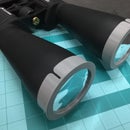Introduction: Lubricate Metal and Inhibit Rust With Moly.
All of my tools live in a garage that isn't temperature or humidity controlled. I run space heaters or a rolling room air conditioner whenever I'm working out there, which means that the majority of the time, my tools are exposed to the humidity of the outside air. This makes iron rust.
I've found rust removing products that will return surfaces to bare gray iron, but I've struggled with ways to keep the rust away permanently. In another Instructable, I stripped the rust from an old table saw, and treated it with Johnson's Paste Wax. This provided a nice smooth surface that didn't interfere with paint and finishes like some oils can, but in the environment that my tools were stored in, it wasn't as permanent of a solution as I'd hoped. The comments section of that Instructable turned into a war about moisture and WD-40 (please don't let that happen to this one!) and everybody and their grandmother prescribed a different home brewed solution for stopping rust.
One commenter brought a new kind of product to my attention, a spray on molybdenum based film lubricant, so I gave it a try. Thanks Lion of Love!
Moly lube is more properly called Molybdenum Disulfide, and one of its many forms is a dry film lubricant that you apply like spray paint. Basically, you clean the metal, spray it on, let it dry, and wipe off the excess. It provides a beautiful graphite like finish, and it's widely purported to be a more permanent rust fix, because it's a dry coating instead of a semi-liquid film that is permeable and easier to wear away.
Here is the step by step of how I applied this dry film lube for the first time.
Step 1: Remove the Rust.
I recently acquired a semi-rusty wood lathe that I needed to clean up, so it became the focus of my moly experiment. If you look at the picture of it, you can see the orange and brown rust on the lathe bed.
I've been using a Rust-Oleum rust stripping product that my local auto parts store sells. You apply it to the clean, rusty metal, and let it foam away the rust. Wipe off the sludge with the dissolved rust and lather, rinse, repeat until you get the results that you're looking for.
A few applications of the product, and you'll have a nice, bare, gray iron finish.
Step 2: Clean the Iron Surface.
Next, I wiped the iron rails down with rubbing alcohol until the cloth came up clean. This is to remove particulate material from the surface, and to remove the rust stripping chemical itself.
It took me about 3 thorough wipes with a clean cloth and alcohol to get everything nice and clean.
Step 3: Mask and Spray on the Moly Lube.
I found a CRC branded moly spray that I used for this project. Many other options exist, but this one was convenient to buy, and is a brand that I trust.
I sprayed a section of my work surface with the lubricant, and noted that it laid down an opaque, paint like layer.
Because of this, I thought it best to mask off the edges of the lathe bed so that I didn't get overspray on the motor and body of the lathe itself.
Then, I sprayed the lube on the bare metal of the lathe bed. Nice, thin, and even coats are the way to go so that you don't end up with drips and runs. The same rules apply from paining anything else.
Step 4: Let It Dry, and Wipe Off the Excess.
The instructions on the moly lube said to let it dry for 10-20 minutes, so I did. The wet and glossy gray finish slowly dulls, and you can visually see when it's dry.
With a clean cloth, I wiped off the powdery excess lubricant, and lightly burnished the surface to clean it.
Since this was the first time I've ever applied moly to this surface, I elected to apply a second coat, followed by the same dry and wipe steps.
Step 5: Inspect and Admire.
After everything dried and was cleaned up, I gave everything a close visual inspection to make sure that I hadn't missed any spots or forgotten to wipe anything off.
It is worth noting that I also sprayed the lube on the underside of the tailstock and tool holder. I coated everything that was bare iron, or that would slide metal on metal with the moly.
If you do get overspray on any surfaces, it cleans up easily with alcohol. Be careful though, it's just as easy to remove the moly from the bare metal where you want it as it is to remove it from the painted parts that you don't.
Step 6: Reassemble the Machine, and Test It Out!
After cleaning up everything and removing my masking tape, I put the machine back together. Everything slid nice and smooth, and I could definitely feel the difference before and after the moly treatment.
Now I've got a nice, clean, lubricated, and rust proof wood lathe to enjoy!! (And it works very nicely, even if I do say so myself)
I'll report back on how the finish holds up over time.
Thanks for reading!













